Chapter 5: LEGO Storage for Large Collections
Considerations for large collections
There are several different ways to store a large collection of LEGO bricks. They range from high-end solutions with a drawer or compartment for each part, to inexpensive ziploc bags stored in larger drawers or bins.
Storage solutions for large collections
There is no “perfect” storage solution because everyone’s budget, storage location, and building style is different. Each of these products will appeal to different people.
- You may choose to use one product for some pieces (such as basic bricks) and another product for everything else (such as rare or seldom-used pieces).
Drawer Cabinets
One of the most popular storage solutions among AFOL’s with large collections are Plastic Drawer Cabinets. They are reasonably priced, and with more than 50 drawers per cabinet you can sort your pieces by Part, or even by Element (Part + Color).
Selection and quality varies greatly, with only one or two brands receiving the majority of attention in a given region. In the United States, Akro-Mils is the most popular brand due to their high quality and fair price, but other brands like Iris and Stack-on (now discontinued) are also popular.
Features to look for in these cabinets include:
- Durable drawers (which bend instead of breaking).
- Drawers that can be removed easily.
- Drawers that can be stacked when they are removed from the cabinet.
- Drawers that are the right size for your needs.
- Cabinets that can be stacked on a desk or table.
- Cabinets that can be wall-mounted.
Recommended Products
Plastic drawer cabinets by Akro-Mils are the top pick for most LEGO enthusiasts in the USA. They have several advantages over other options including: drawers are easily removed and stack-able, drawers are deep enough for 16-stud bricks, drawers are flexible which makes them hard to break, and have competitive prices.
The drawers have interior measurements of 5.0 × 13.3 × 3.7 cm h (2 × 5¼ × 1½″ h), and a volume of 0.25 liters (15¼ in³).
In addition to the 64-drawer cabinet, Akro-Mils offers cabinets with larger drawers. The 24-drawer cabinet contains only large drawers, and the 44-drawer cabinet includes a mix of small and large drawers.
The larger drawers have interior measurements of 10.8 × 13.3 × 5.3 cm h (4¼ × 5¼ × 2″ h), and a volume of 0.76 liters (46⅓ in³).
Drawers with dividers
If you want to store your LEGO collection like the LEGO design studios in Billund, you want large drawers with divided compartments. Drawers with dividers allow you to keep a large collection meticulously organized, and they take up less wall space than the drawer cabinets highlighted above. These cabinets are especially well suited for people who want to separate pieces by Element (Part + Color) instead of just by Part.
I’ve seen beautiful examples of drawers with every common brick and plate of a single color in one cabinet, or alternately, every color of a single part in a single drawer. Which organizational scheme you pick will depend on whether you think about the LEGO library of elements by color first, or by part first.
Recommended Products
This UK company makes the only storage drawers designed specifically for LEGO Bricks. The dividers are removeable, and each compartment is slightly larger than 8×8 studs.
Drawers can be configured with up to 15 compartments measuring about 7 × 7.5 × 6 cm h (2¾ × 3 × 2⅓″ h), with a volume of 0.32 liters (19 1/4 in³).
Really Useful Products makes high quality drawers designed for scrapbooking, and an optional divided insert with 15 compartments that works great for large LEGO collections. These are really large drawers that can hold a lot of LEGO bricks.
With the insert, each of the 15 divided compartments are 10.5 × 7.0 × 7.5 cm h (4⅛ × 2¾ × 2⅞″ h), with a volume of 0.55 liters (33.6 in³).
Each compartment in the Really Useful drawers is about 70% larger than the Papimax Drawers. Because each compartment is so large, the Really Useful Drawers are most appealing for extremely large collections and large LEGO rooms.
Note: Both of these options are now available in the US. They are fairly expensive specialty products, and can only be purchased direct from the manufacturers.
Removable Compartment Organizers
One of the newest products to gain popularity with LEGO builders is a new kind of tackle box with removable compartments. Many LEGO builders like how these have tight-fitting lids, but you can remove just one compartment and bring it to your build area.
These products typically come in both a regular, and deep option. The shallower options are better for people who want a lot of small storage containers, especially when sorting by Part or by Element (both Part and Color). You typically get more compartments this way, and they aren’t as deep so it’s easier to remove parts from the bottom of each compartment. The deeper options only make sense if you sort by both part and color, and have a lot of basic bricks that you need to store.
Recommended Products
With 25 removeable compartments, this is a great option for collections which are very well organized. A tight-fitting lid makes this perfect for portable LEGO Collections.
They also offer a deeper version of this product with just 10 larger compartments.
Stanley also offers a more expensive FatMax option which is probably overkill for LEGO storage.
It is also sold under the Dewalt brand, which might be cheaper.
Tackle Boxes
Tackle boxes are popular in the crafting community, and they are popular with LEGO enthusiasts as well. These containers have divided compartments and a tight fitting lid, and are less expensive than some other options. The most common designs have a lid which is attached to the base with a hinge, and the size of each compartment is often adjustable with plastic dividers.
Accessing a specific part is a bit slower than some other solutions, as you need to find the right container, fold it open, and carefully remove the parts you need without causing an earthquake (where parts end up shifting into the wrong compartment.) That said, they are extremely portable, making them a great choice for younger builders, or people who need to bring parts to a LEGO convention. It’s also a good deep storage option for well-organized builders who need an inexpensive and efficient storage solution for less frequently used parts.
- Plano Tackle Boxes – Tackle boxes come in a wide range of sizes, but the larger sizes can hold more LEGO bricks. I recommend the 3700 Series which is 14 × 9¼ × 2″ tall, and has up to 24 compartments. The smaller 3600 Series is 11 × 7¼ × 1¾″ tall, with up to 21 compartments. (Anything smaller than this is probably too small for LEGO bricks.)
- Plano Multi-tray Tackle Box – For the ultimate in well-organized portable storage, consider one of these large tackle boxes which store up to four tackle box trays. The Plano 1374 Rack System holds four of the 3700 Series Tackle Boxes recommended above.
Plastic Bags
Plastic bags are one of the cheapest and most commonly used LEGO storage containers. It helps that they are very easy to find — you can buy them at almost any grocery store. That said, not all bags are created equal… Premium bags don’t cost much more, but they include convenient Sliding zippers, and are designed to stand up when placed on the ground. This might not seem like a big deal, but it’s really helpful since you can leave a bag unzipped without worrying about it falling over and spilling pieces all over your workspace.
Plastic Bags are especially well suited as overflow storage for people with very large collections — you can stack a lot of bags in a box or large drawer without wasting space. (Plastic Bags are also useful for storing sets, manuals, or other LEGO accessories.)
I strongly recommend having bags available in all sizes: from small 3 × 5″ bags to very large 2.5 Gallon bags — They are inexpensive, and you never know when you will need them!
- Ziploc Slider Stand & Fill Bags – This is the premium option for storing LEGO bricks in bags. The slider makes it easier to open and close, and the bag stands up while you fill it. Available in Quart, Gallon, or a Variety packs. (For even larger quantities, or to store a complete LEGO set, try the Hefty Slider 2.5 Gallon Bag.)
- Standard Plastic bags – The most common sizes are Sandwich, Quart, and Gallon. The name brand regular bags cost almost as much as the Slider bags, but you might be able to find inexpensive generic bags at your grocery store. The “Freezer” bags are thicker and more durable, but more expensive. (I really like the Snack Size, which is the same width as the Sandwich size, but half as tall. It’s perfect for small parts and accessories.)
- Small Bags – If you’ve ever purchased LEGO bricks on Bricklink, you probably received some of them in very small plastic bags. The smallest size I can recommend are the 3 × 5″ bags, which are cheap and can hold a fair number of pieces. (The 2 × 3″ bags aren’t very useful, although they are large enough to store a couple bricks or a single LEGO Minifigure.)
Open-front Bins
While they are designed for industrial applications, some professional LEGO builders use open-front storage for common bricks. This storage solution takes up a lot of space, so it only makes sense if you have a very large quantity of common elements.
The main concern with this storage solution is that it is expensive, takes up a lot of space, and pieces can fall out if the container is too full.

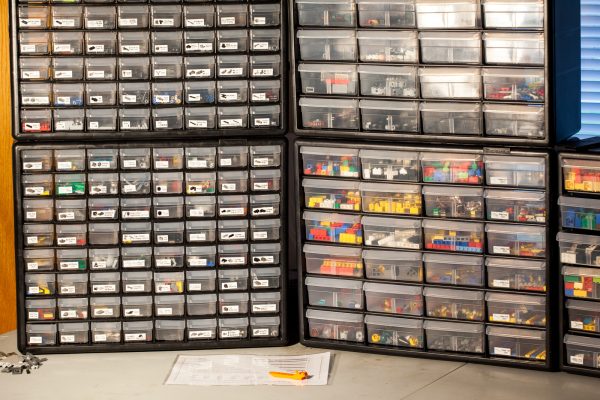


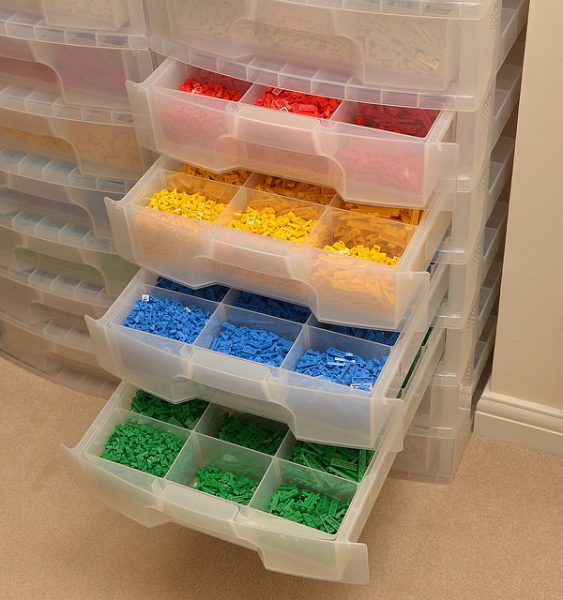
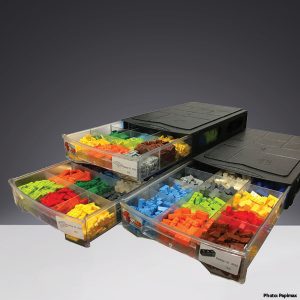


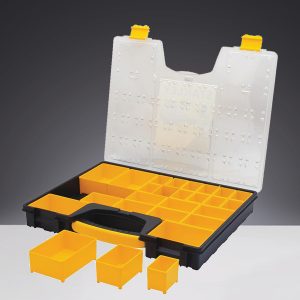
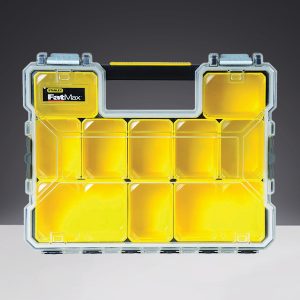
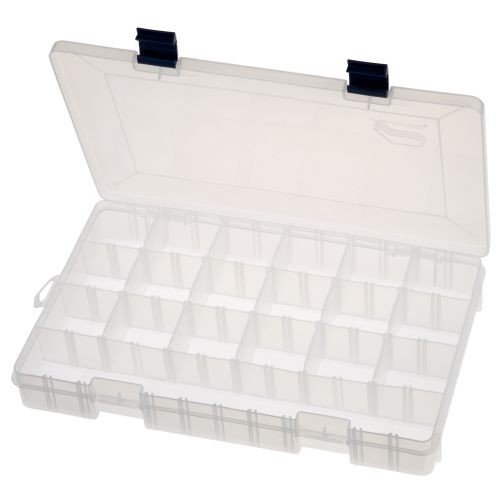
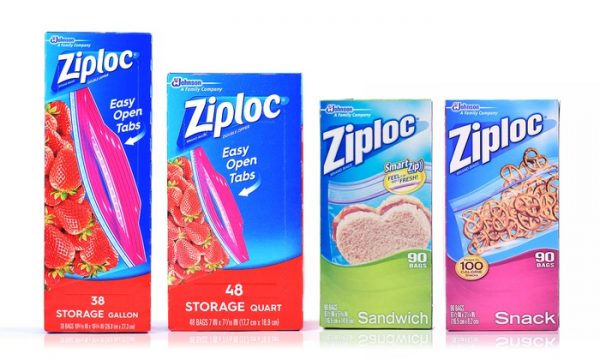
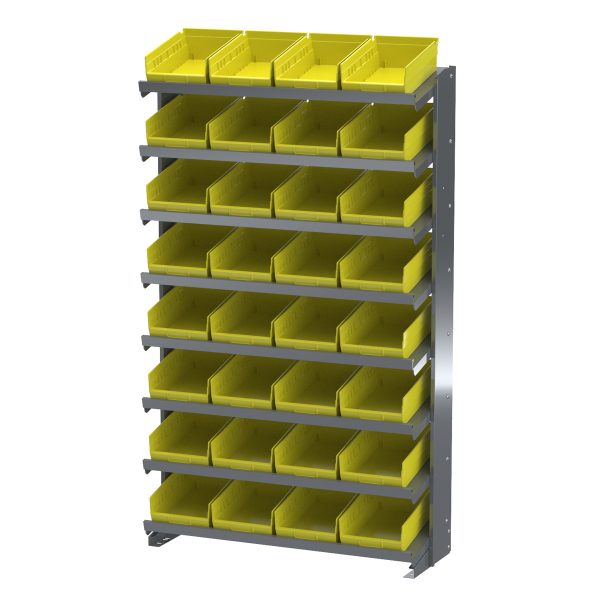
I re-configured Iris/Sterilite drawer organizer to be two storage system – each storage system is 6 feet high by 8 feet long by 1 feet deep – each column is bolt to the next column every 1 feet of height of the column to add stability to the frame.. My combine storage space for small Lego spare parts is 6 feet by 16 feet by 1 feet. The plastic frames from iris are stronger and more rigid than the ones from sterilite. the Iris unit has small and medium size drawers. The Sterilite has medium and large size drawers.
Walter, I have also observed that the Iris drawer cabinets are a little more stable. The main advantage of Sterilite is that it is often cheaper.
Lego bins for organization.
My collection fills a room so these are solutions were inadequate. I use the Seville storage 10 drawer organizer cart. https://smile.amazon.com/Seville-Classics-10-Drawer-Translucent-Color-Coded/dp/B01N9FFR6P/ref=pd_sim_201_12?_encoding=UTF8&psc=1&refRID=78KCD36WF30RA94S7733
They are sturdy and I like the colored ones because it helps me remember where parts are. I labelled them. Then I bought card stock and cut it and folded it to create paper bins. They are cheap, cut to fit the bin exactly, and removable. No plastic bin comes close to making them myself. I can send pics of what I did if you want to post them, because it seems to be different from what others do and it is a pretty cheap solution. I agree with the person above about the portable Stanley organizer with 16 removable bins for minifigs. https://smile.amazon.com/Stanley-Removable-Compartment-Professional-Organizer/dp/B001G1CUK0/ref=sr_1_2?ie=UTF8&qid=1510267496&sr=8-2&keywords=stanley+bin+organizer
and 25 compartment is very good for small components.
https://smile.amazon.com/Stanley-Removable-Compartment-Professional-Organizer/dp/B00005QWYF/ref=sr_1_2?ie=UTF8&qid=1510267496&sr=8-2&keywords=stanley%2Bbin%2Borganizer&th=1
Lars, I will be adding these Stanley-style cabinets to the guide soon. Several people have suggested them, and I even use one for my extra LEGO Architecture Studio set which lives at work.
Although the Seville drawers seem to work well for you, I’m not as fond of them because the sloping walls make it harder to subdivide into smaller compartments. While most people I’ve talked to prefer clear drawers, I can see how you would eventually learn which color contains the parts you need.
I use the 3 and 5 drawer Sterilite bins commonly found at WalMart/Target ect. This is cheapest option I have found. I bought some additional plexiglass sheets at HobbyLobby and cut them to size to make dividers, securing it with hot glue, in the shallow bins. This is great for your less common colors in smaller quantities. I sort by color and type. Keeping them seperated in ziploc bags, going in bins for respective color. For items I have large quantities of like slopes or bricks, ill use entire large or small bins. I use $4 Plano tackle boxes from walmart for all my minifigure accessory sorting.
That sounds like a lot of work, but I’m sure it works great now that you are done. I also use a combination of separate compartments and small ziploc bags to sort my collection.
I personally love to combine large and small drawers with large drawers with individual trays inside. In my personal opinion this is the best way to get the convenience of having the fast cleanup and parts access of large draws with the portability and specificness of small single section trays. And if you find a modular system, the trays can be easily shuffled around as collection changes. The main problem is finding trays that fit well in drawers with little wasted space. As of yet I have not found the perfect solution but I currently am making my own trays so I really have not looked much. That’s just how I like to do things in may small workspace.
Zane,
I have heard similar experiences from other LEGO builders. What you are discussing is the process of creating your perfect LEGO Storage Solution using a combination of different LEGO Storage Products. This is something that I plan to expand-on in a future addition to the guide.
(To summarize your personal storage solution – you use a mixture of Akro-Mils style drawer cabinets and larger drawers with multiple rows of small removeable compartments inside. That’s very similar to my storage solution, although the individual compartment in the Really Useful Scrapbooking drawers I am using are not removeable.)
Thanks for your support and feedback!
—tom
When I was getting started and needed to organize, I researched the drawers like the stack-ons listed above. I thought the price was a bit high and kept shopping. Found the exact same stack on 39 drawer organizer at Home Depot for almost 1/2 the price ($16). https://www.homedepot.com/s/stack+on+organizer?NCNI-5. According to homedepot.com it looks like they might be sold out now. Still worth looking into.
Gary,
I think the important point you are making is that it is a good idea to shop around. Amazon has great prices on most things (in the USA at least), but you might be able to find slightly better prices if you shop around or wait for a sale.
—tom
The Akro Mills units are commonly available at Menards stores in the midwest for about $20.
I’ve found that there is a step up from tackle boxes- cases with individual bins. Stanley makes a popular one in shallow and deep sizes. They have the advantage of removable bins like a drawer organizer but also locking lids that keep all the parts in like a tackle box. The bins can be rearranged between boxes of the same depth, allowing your collection to grow organically.
This is an obvious gap in the guide which I will remedy very soon. Added your comment to my backlog in the appendix.
Just as Really-Useful-Boxes are hard to get in the USA, so Akro-Mills is hard to source in the UK. Other similar options available worldwide include Raaco (see Dennis Bosman’s flickr archive for example).
Maybe this is covered somewhere else in the book but I’m going to jump in here anyway. Since we are talking about large collections, other key tools helping me keep my 1.7M collection manageable are:
A small scale for weighing bulk parts. Saves a lot of time.
A bakery rack for storing parts to be washed or sorted, WIP, table scraps, or odds and ends waiting for a place in the system. That way it is not cluttering my build tables.
A wire 3 shelf cart for when I am either pulling or organizing parts. It’s especially helpful when I have to get parts from the section with Plano containers as you need somewhere to put them down to open them for part access.
For fiddlybits I also use the small Akro-Mils cabinets but for large parts and quantities, I use easily available Sterilite and Iris stackable units, the IRIS being more expensive but sturdier for stacking floor to ceiling. IRIS made the drawer sets that LEGO sold for a while.
My challenge was finding flexible dividers for the drawers. With fixed divided drawers it becomes very inefficient when you don’t have the same amount of each color. I sort by Category/Part/Mold variation/color. I use Categories defined by Bricklink.
Sterilite: I have found this plastic insert from Consumer Craft (https://www.consumercrafts.com/store/details/catalog/papercraft-storage-and-organizers/1203-66tray) which fits perfectly into the large drawers and be cut to fit into the medium ones. Not perfect but cost effective. Found on sale with free shipping about $1/drawer.
IRIS: They make a divided tray for their wide drawers but two things problematic; they don’t sell extra dividers which limits their usefulness and they don’t ‘snap’ in which can be undesirable for very small parts for which the trays are best suited!
ALL: My ideal solution is the containers from Schaller Corporation (www.schallercorporation.com). As your collection grows or changes you can easily readjust the drawer configuration. Also, they can be easily moved to your build area with you don’t need the whole drawer. More expensive, averages about 0.80 per piece, but I am in organizing heaven with these.
Michele – thanks for the tip re: the Consumer Craft plastic insert for the Sterilite drawers! Are these the medium drawers that you said they can be cut to fit into? https://www.target.com/p/sterilite-174-3-drawer-medium-organizer-white/-/A-14779288
And if so, how much of a trim do you have to give them? Just trying to figure out how labor-intensive this will be before I order a ton of them. 🙂
All you have to do is cut one or the other end off or cut them in strips and ‘customize’. A medium drawer accommodates three strips of the full insert. Not the perfect solution as I have not employed anything more sophisticated then kitchen scissors as a tool (you can get ragged or sharp edges) but it works well enough for the price!
Great, thank you very much!
I have a couple of sets of these smaller RUB drawer systems – they are expandable by adding individual draws – for storing small pieces – round studs, 1×1 plates, 1×2 plates, weapons, tools, “accessories”, rods, tiles, cheese slopes, small bows etc.
http://www.reallyusefulproducts.co.uk/uk/html/onlineshop/rub/rRoboM09x0_9lDrawerTower.php
(I have the glitter set which has multicoloured draws so I know which draw I’m looking for)
They are great as they are only about 3/4″ high for each draw so it is easy to find the bit you are looking for – and they aren’t too big that if you are really stuggling to turn the whole content out onto a plain tray to find the bits you want – my (our) “loose” collection is probably about 30,000 bricks of mixed SW/friends/technic/… and at the moment these are about the right size for most of these categories – some (e.g. 1×2 plates) are split into “colour groups”…
They are portable and have the advantage you can easily pull them fully out to sort through the pieces when struggling ….
Hi,
It would be great if you could compile a comprehensive list of storage products used by AFOLs around the world. I suspect many of the solutions are going to vary by region because these things are bulky and expensive to ship. I haven’t seen the Akro-Mils drawers on this side of the pond, but one reasonably priced alternative is the Raaco 44 drawer unit, available in the UK from CPC: http://cpc.farnell.com/raaco/126762/44-compartment-steel-frame-cabinet/dp/SG32824
I use ArtBin boxes – there are different models, from single compartment, to fixed compartments, to removable divider compartments. Specifically the 9101AB, 9007AB, 6955AB, and the 6990AB. They are all 14″x15″, and five 9101ABs are as tall as 3 9007AB or 3 6955AB. The 9101AB has lots of removable dividers, you can buy more if you need them, and is great for storing Lego pieces. The larger boxes are for those larger pieces, or for those pieces you have too many of. There are two drawbacks: 1. cost, 2. despite looking like tackle boxes, the lids don’t fit tightly enough for easy transportation. You have to keep the boxes flat, basically.
Incidentally, using this type of box, I recommend sorting by colour per box, and inside the box by part. It means if you want to build something you need fewer boxes because more parts in the colour you’re working with will be in the same box.
Hey Tom, Saw your presentation at Brickcon and thought it was fantastic . I would like to add the Legendary Ikea Antonius tray to the recommended sorting trays.
http://www.ikea.com/ca/en/catalog/products/50043573/
Pros – Cheap , Sturdy , can be removed from shelves to be places on work area. easily adapts to accept large quantities of new acquisitions.
Cons – requires custom made storage racking for maximum benefit.
I emailed you some photos of my setup .
Love those. I haven’t gotten around to any kind of racking for them, but love that I can stack them easily, and they’re great for working on big projects, having a lot of pieces in each. Also really great for sorting.
Hi Tom,
I would consider writing a small section about plastics and how they affect storage. Example, there are some differences between how polyethylene and polypropylene plastic bags function, and there are also a lot of polyvinyl-chloride baggies out there that simply should be avoided. Some storage solutions also wind up being constructed out of plastics that can be damaging over time. Not always to the ABS of LEGO Bricks, but they conduct temperatures and humidity differently, and in some climates it can be the difference between LEGO bricks with filmy or moldy surfaces or not.
I haven’t read ahead to see if you have mentioned UV light, but it should be covered as well. Not just direct, but ambient reflected light from windows and also the UV light from some light bulbs. I recently had an issue with some CFL bulbs drastically affecting the color of some of my bricks.
Thanks,
Ken
Ken,
The issue of “archival” plastics which do not damage LEGO bricks is important, as is the discussion of the impact of UV light to LEGO bricks, especially certain colors like White. I’ve added this to my to-do list in Appendix: Version History & Acknowledgements.
Tom, the open Akro Mils drawers would be great, but dust on parts can be frustrating. I’d like to see drawers with clear lids which would open when you pulled the drawer out, and close as you shut the drawer. I don’t know if these exist or not.
I am enjoying your beta book; learning a lot! Thanks for letting us read it.
[::] Jack
Jack,
I have not experienced problems with dust while using the Akro-mils style cabinets. While they aren’t airtight when the drawers are closed, there isn’t a very large gap to allow dust to enter.
I am not aware of drawers with lids which open when you pull the drawer out.
Good luck!
—tom
I have the same problem… I’m not at the point, location or situation where I can securely mount these units on the wall and as such find these units chock full of dust, daily as the backs of these units are wide open. I love the stack-ability, usability and sort-ability but have reverted back to Plano boxes for just this reason… Still looking for Akro Mils or another company to enclose the back of the units, would add rigidity as well.
Ryan, you could always tape a piece of cardboard or plastic to the back of the akro-mils cabinet.
That’s what I did when I lived in a dusty home and couldn’t wall-mount – just taped big panels of cardboard over the back of the frame. Reduces dust infiltration to essentially nil unless you’re just letting dust pile up on the frame and drawer handles. Even taping a paper bag over the back would work as long as you cover the mounting holes and the gaps in the frame.
Hi Tom, just a thought:
I use three different types of tackle boxes – red, blue, and yellow – they have different tray sizes. Advantage: this solution is stackable – example:
https://www.amazon.de/dp/B0002YYXUM/ref=twister_B01MZ0OJVH?_encoding=UTF8&th=1
( Hünersdorff 611900 Sortimentskasten )
If a brick is out of stock of these boxes, I use in parallel plastic bags with the equvalent brick types. This is my “big” store.
So I can decide quick and easely to reorder. The plastic bags are stored in boxes like you presented the “under-bed storage” solution 🙂
Best regards, Andy
Andreas,
Thanks for sharing a link to a product which is versatile and works well with your collection. I love that there are versions with different size compartments, but the outside dimensions are the same so they stack well. I will consider offering a link to this product when I expand the article to include international product links.
As for your system which includes overflow storage in plastic bags which are kept under the bed, that makes perfect sense to me! It’s not just about picking one product, but picking a set of products that work well together; finding the perfect LEGO Storage Solution for you!
Sincerely,
—tom
I also use small containers that are normally used for storing food (in your fridge or so). I take of the lids and stack them. I’ve started to use these as they are cheap, durable, and don’t waste space as I stack them with the lids off.
A challenge I have is to find the piece I needed. The solution, I give all the parts that I store, a storage location like xxx.yyy, where the xxx points into the right box/cabinet/bag and the yyy the location in that box/cabinet/bag. Searching was never that easy, but also during the breaking out, it is easy to find the right spot.
Ralf, thanks for sharing this idea. I’ve already added a section on creating an “index” to the guide.
I would also consider sterilite drawers that come in small, medium, and large sizes. Those small acro mills ones fill up very quickly. The small and large come apart and can be reconfigured to stack securely as high as you like. I currently have a 12×12 back of small drawers for most parts, with, 27 medium (9 units, and 9 large for very common parts I have a lot of. I also have an 6 stack on combo drawers and 2 acro mills small drawers for the rarer stuff. It’s worked out really well after a lot of trial and error. I find the tackle boxes and divided cases are a pain when you need to break out a large box for a single part, and often you need several for a category of part, especially technic. Anyway, food for thought
Josh, thanks for the feedback. I agree that there are some medium-sized drawers that I should add to the guide, and look forward to hearing more about the specific Sterilite drawers that are working well for you.
thanks,
—tom